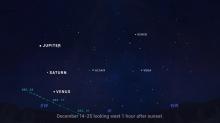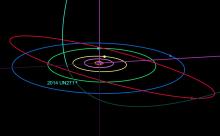Listen to today's episode of StarDate on the web the same day it airs in high-quality streaming audio without any extra ads or announcements. Choose a $8 one-month pass, or listen every day for a year for just $30.
You are here
Eta Aquarid Meteors
A meager but reliable meteor shower should be at its best in the hours before sunrise tomorrow. There won’t be any moonlight to interfere with the show, so it’s worth a look.
The Eta Aquarid shower is spawned by Halley’s Comet. As the comet orbits the Sun, it loses grains of rock and dirt. Earth flies through this trail of debris twice a year — in May and October. When it does, some of the comet dust rams into Earth’s atmosphere. The debris is moving at about 150,000 miles per hour, so the particles quickly vaporize. That produces the glowing streaks known as meteors or shooting stars.
The meteors all enter the atmosphere from the direction of the star Eta Aquarii — hence the shower’s name. They can fly across any part of the sky, though, so you don’t have to look toward Aquarius to see them. But the shower is best after Aquarius rises, around 4 a.m.
Eta Aquarids are best viewed from the southern hemisphere. That’s because Aquarius climbs higher across the sky, and it’s in view longer before sunrise.
Here in the United States, the view gets worse as you work toward higher latitudes. From Austin, there are about two and a half hours of good viewing time, with a peak of perhaps a dozen meteors per hour. From Seattle or Milwaukee, though, the viewing window lasts only about one and a half hours, with almost no meteors in view.
Still, occasional bright ones do zip across the sky — bright sparks from a comet.
Script by Damond Benningfield






